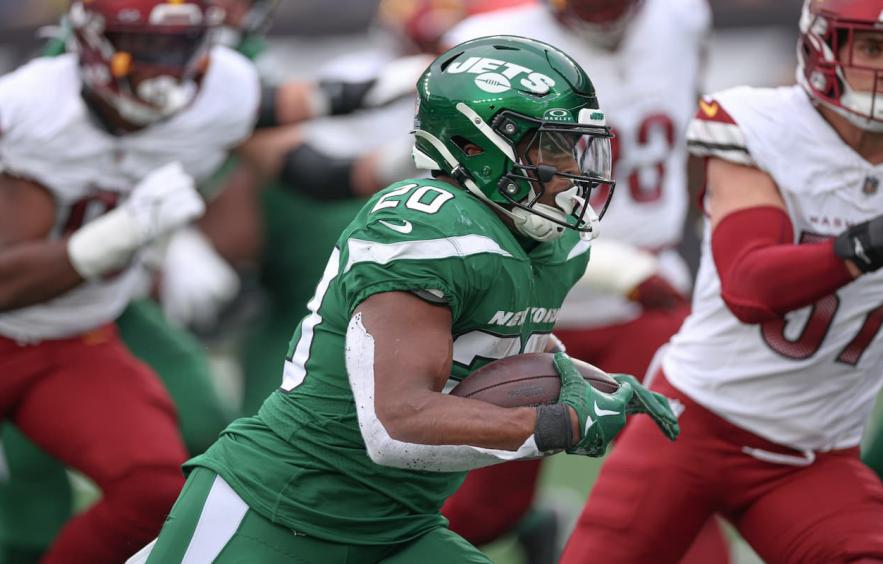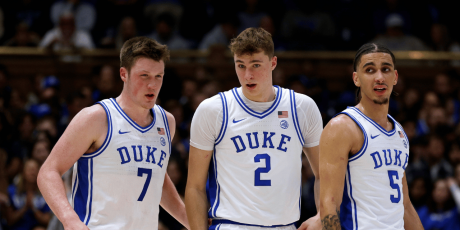Who Should I Draft with the 3rd Pick in Fantasy Football

To nail your fantasy football draft, you need the right strategy, along with savvy player takes. This article outlines the best player to draft with the third overall pick, along with tips for filling out the remainder of your roster based on ADP and specific scoring settings.
Our Perfect Draft series covers multiple draft spots in various scoring formats and league sizes using Draft Hero software. Find your perfect draft today!
Standard League: RB Breece Hall, Jets
Breece Hall was dealt the worst possible hand last season. Coming off an ACL tear of his own, Hall had to play with three below-average backup quarterbacks while running behind an injured and ineffective offensive line. The Jets offense as a whole scored under 16 points per game, fourth-lowest in the NFL. And still, in a fantasy football format that is heavily reliant on touchdowns, Hall finished as the RB12 in fantasy points per game.
Heading into 2024, Hall will be lining up behind future Hall of Fame quarterback Aaron Rodgers and running behind a vastly improved offensive line that brought in two solid, veteran offensive tackles in free agency. When looking at the betting markets, only Christian McCaffrey has better odds of winning Offensive Player of the Year at the running back position. Hall has 15 touchdown upside, and he can reach 2,000 total yards in what will be a vastly improved Jets offense.
Last year, twice as many running backs – compared to wide receivers – reached 200 standard fantasy points. Starting with Hall is a smart way to begin your draft positionally. Sam LaPorta was the lone tight end to even reach 150 points (153) in 2023. Running backs, wide receivers, and tight ends all catch passes, yet standard scoring does not reward fantasy points per reception. This makes the quarterback position relatively more important since none of their fantasy scoring comes from catching passes. Seven quarterbacks reached 300 total fantasy points last year, while McCaffrey was the only non-quarterback to hit that mark in 2023.
After selecting the Jets bell cow, another high-workload running back can be selected within the next two to three rounds, along with an elite quarterback. While receivers do have lower upside than running backs, the top receivers do provide stability and a solid fantasy floor. Two to three receivers should be added by the sixth round in most drafts. Unlike PPR and half-PPR leagues, a large portion of winning teams will have a running back in the flex.
Best Alternative Pick: Bijan Robinson
Robinson is a very similar bet to make, where you’re selecting a young, workhorse running back with massive volume and touchdown upside. The Falcons, like the Jets, should be a much-improved offense in 2024 with the addition of Kirk Cousins.
PPR Scoring: WR Tyreek Hill, Hills
PPR is where wide receivers truly shine as opposed to standard scoring leagues. Tyreek Hill just became the first player in NFL history to record back-to-back seasons with at least 1,700 receiving yards, and he caught exactly 119 passes in both seasons. Hill’s 23.5 PPR fantasy points per game were only surpassed by McCaffrey (24.5) and CeeDee Lamb (23.7).
The situation in Miami sets up similarly for Hill in 2024, with Tua Tagovailoa at quarterback and Jaylen Waddle as the primary target competition. The Dolphins’ defense was ransacked by injuries last year, and starting edge rushers Jaelan Phillips and Bradley Chubb are both expected to miss time as they recover from late-2023 season-ending injuries. This depleted pass rush could lead to more shootout game environments for Hill and the Dolphins pass attack.
Drafting a strong stable of wide receivers is the most critical part of nailing a PPR draft since giving a full point per reception will naturally benefit the position (WR) that catches the most passes per game. Once Hill is on your fantasy roster, it’s good practice to add two to three more receivers by Round 6 or 7.
When looking at the 2022 and 2023 seasons, 13 running backs, 22 wide receivers, and just one tight end have reached 250 PPR fantasy points.
Similarly, 50% more receivers have reached 17 fantasy points per game over the past two seasons compared to the running back position. Most championship teams in PPR leagues will start a wide receiver in the flex position.
Elite quarterback strategy can still be effective in PPR formats, but it’s definitely not as critical compared to standard scoring leagues. For this format, tight ends in high pass volume offenses who are the #1 or #2 pass catcher on their team should be considered in Round 4 or 5.
Best Alternative Picks: Breece Hall or Ja'Marr Chase
Breece Hall was the pick in standard scoring, and after leading all NFL running backs in receptions last season, he’s a solid alternative for those taking an anchor running approach in drafts. Chase is half a decade younger than Hill, and while he hasn’t consistently put it together in fantasy yet, he’s the one other receiver with 50 fantasy point weekly upside.
Half-PPR Scoring: RB Breece Hall, Jets
Over the past five seasons, there have been seven running backs and just two wide receivers to reach 20 half-PPR fantasy points per game. Naturally, this gives a slight edge to Hall over Hill.
Additionally, Hall has the more favorable schedule down the stretch. His final seven opponents are the Cardinals, Colts, Seahawks, Dolphins, Jaguars, Rams and Bills. There’s a real possibility none of these teams end up ranking as a top-10 most difficult fantasy matchups for running backs. Hill’s final seven matchups are the Raiders, Patriots, Packers, Jets, Texans, 49ers, and Browns, and there’s a real possibility five or six of those teams rank in the top 10 most difficult fantasy matchups for wide receivers.
In a half-PPR league, a blend of the standard and PPR formats is recommended. Elite quarterbacks and tight ends fall in the middle here, where neither are slam dunk picks, but they can both be part of a well-rounded fantasy roster with upside. Make sure to have three to four wide receivers by the sixth round in a half-PPR league to make sure you’re not boxed out at the position.
Best Alternate Pick: Tyreek Hill, Bijan Robinson or Ja’Marr Chase
Hill and Chase are the alternatives for wide receiver heavy drafters, while Robinson is in the same running back tier as Hall.
Superflex: Patrick Mahomes
Superflex drafts are far less predictable than the other 1-QB formats, but the safest way to begin your draft is with a quarterback. Assuming Jalen Hurts and Josh Allen are already off the board, Mahomes should be the next pick in this format. With a below-average supporting cast, Mahomes was still the QB10 in fantasy points per game last year. In his other five seasons, he’s had three top-two fantasy finishes and the other two were QB5 and QB6 in fantasy points per game.
Mahomes isn’t the rusher that Hurts and Allen are, but he’s still a tactical scrambler who runs for roughly 350 yards annually. As an NFL starter, Mahomes’ 17-game averages are 5,036 passing yards and 39 passing touchdowns. Simply put, no quarterback is on Mahomes’ level as a passer.
It’s important to read the room in a superflex draft. Once you’ve selected Mahomes, you don’t need to force a second quarterback immediately. For your QB2, don’t let more than 15-18 quarterbacks get drafted before filling out that slot. It’s fine to start your superflex draft QB-QB, but most draft rooms won’t be QB-thirsty enough for this to be optimal.
Through five or six rounds, try to round out your team with two or three wide receivers, along with one or two running backs. High-end fantasy running backs and receivers can rival quarterback scoring, but it’s rare to see a tight end perform like a top-12 quarterback in fantasy. If you need to de-prioritize a starting spot in superflex, make it your tight end or second running back if going particularly wide receiver heavy.
Best Alternate Pick: Christian McCaffrey or Lamar Jackson
McCaffrey can actually out-score all the quarterbacks in a given season. Jackson’s rushing yardage is stronger than practically any other quarterback, but his lack of rushing near the goal line has prevented him from consistently reaching the weekly ceiling that Hurts and Allen have. Jackson’s 2019 season is the best fantasy season by a quarterback all-time, but his rushing has fallen slightly in recent seasons.
Top Late-Round Targets
Late-round picks should complement your draft strategy from the early and middle rounds. For example, if your team includes several early receivers, take more shots on running backs late.
These ground rules for your fantasy bench should help you stay on track towards the end of your draft:
-
If you took an elite quarterback or tight end, a second one is not needed
-
Always keep at least two handcuff running backs on tap in case of injury
-
Prioritize your opponents’ backup running backs, as opposed to your own
-
-
Stash at least one rookie or second-year player
-
Wide receivers should be under the age of 29
-
When deciding between two players, choose the younger option or the one on the better offense
Before outlining a couple of players that fit these bullet points, if your league starts a kicker and defense, wait until the final two rounds to fill these slots.
Curtis Samuel: The Bills signed Samuel to a three-year deal, reuniting him with offensive coordinator Joe Brady. The two were last paired in Carolina in 2020 when Samuel had career-highs in receptions (77) and total yards (1,051). Buffalo shed talent this offseason with both Stefon Diggs and Gabe Davis no longer on the roster. Samuel has a slight chance to challenge Dalton Kincaid as Josh Allen’s top pass-catching weapon this season.
Jaylen Wright: The Dolphins prioritize speed at running back, and Wright ran a blistering 4.38 40-time at 210 lbs. at the NFL Combine. The fourth-round pick has home run ability with the ball in his hands, along with some pass-catching chops. Both Raheem Mostert (RB3 in fantasy points per game) and De’Von Achane (RB4) thrived last season in a Miami offense that scored the second-most points in the NFL. If anything happens to the 32-year-old Mostert or the undersized Achane, Wright should be fantasy-relevant.
Below, you can see a realistic 16-round draft with the third overall pick. The following table provides the round you can expect to draft each player in a typical, 12-team half-PPR fantasy league.
| QB | RB | WR | TE | K | DST |
|---|---|---|---|---|---|
| Anthony Richardson | Breece Hall | Drake London | Mark Andrews | Jake Moody | Buffalo Bills |
| Jaylen Warren | Brandon Aiyuk | ||||
| Brian Robinson | Christian Kirk | ||||
| Jonathon Brooks | Chris Godwin | ||||
| Tyler Allgeier | Brian Thomas Jr. | ||||
| Jaylen Wright | Curtis Samuel |
| QB | RB | WR | TE | K | DST |
|---|---|---|---|---|---|
| Round 5 | Round 1 | Round 2 | Round 4 | Round 16 | Round 15 |
| Round 8 | Round 3 | ||||
| Round 9 | Round 6 | ||||
| Round 10 | Round 7 | ||||
| Round 13 | Round 11 | ||||
| Round 14 | Round 12 |





















